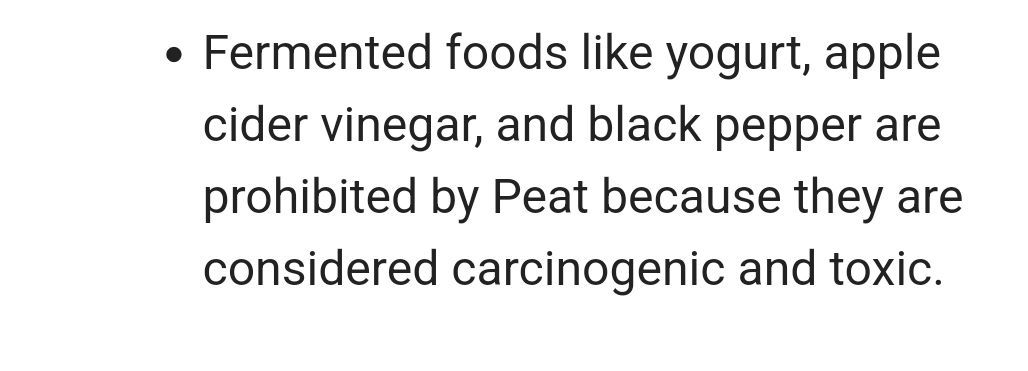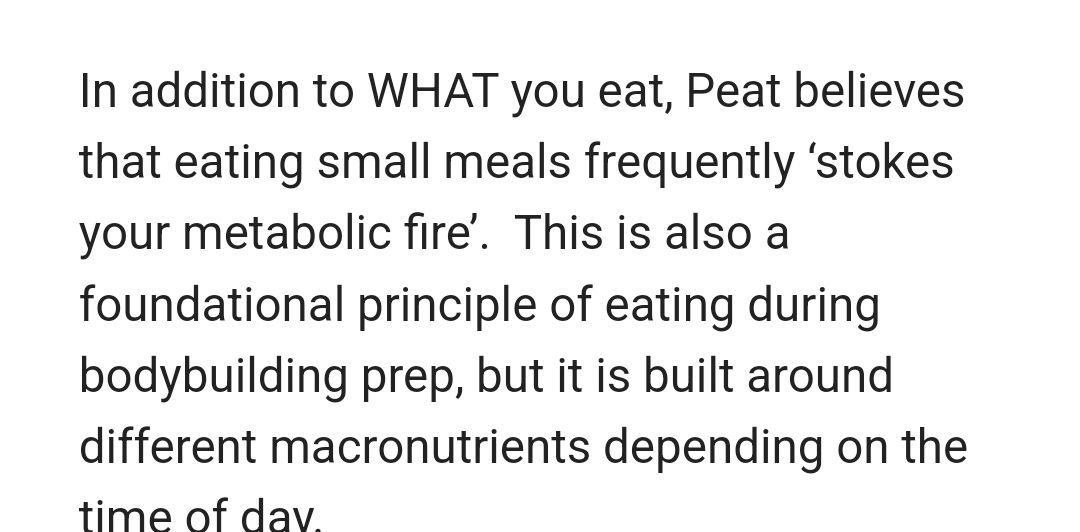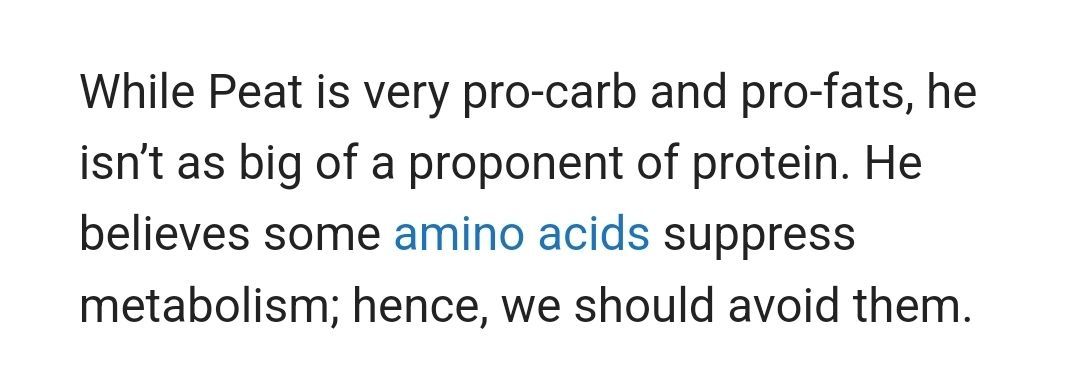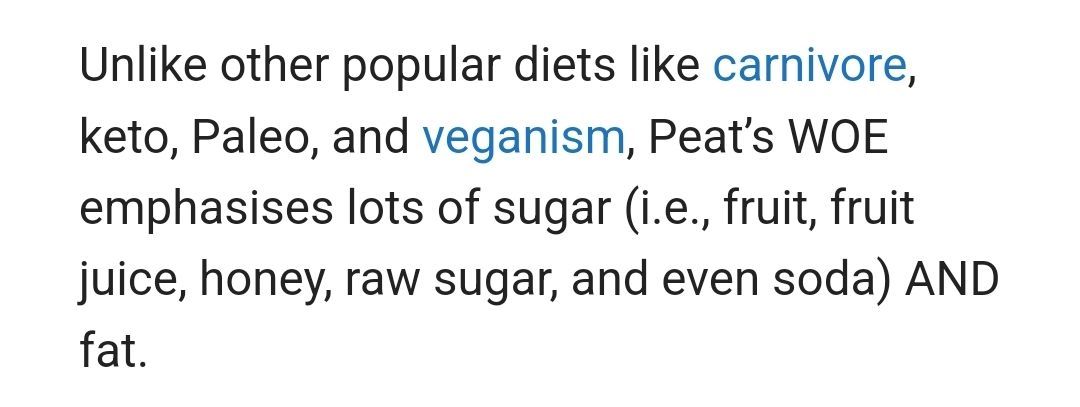I don't know if you can find Dr. Mercola and Strong Sista's videos on how bad PUFA is.
I prefer Strong Sista's as Dr. Mercola is getting old and he is starting to wonder off the subject or ger too detailed, and unaware he has lost the audience.
Dandruff or scalp irritation? Try BLOO.
I don't know if you can find Dr. Mercola and Strong Sista's videos on how bad PUFA is.
I prefer Strong Sista's as Dr. Mercola is getting old and he is starting to wonder off the subject or ger too detailed, and unaware he has lost the audience.
@Mossy said in is 0.768 ppm lead for ceylon cinnamon too high?:
@sneedful said in is 0.768 ppm lead for ceylon cinnamon too high?:
they powder it themselves in USA and i doubt they are using a machine with lead so it is probably naturally occuring lead from Sri Lanka
This is a good question and timely for me. I've been attempting to get spices and herbs with as little contamination as possible, and I'm finding that this is not easy to do, especially for Ceylon cinnamon. If what I'm finding is correct, Ceylon, of all cinnamon, is currently not even available without contamination:
https://www.mamavation.com/food/cinnamon-lead-cadmium-glyphosate.html
I realize you have to take these reports with a grain of salt, as there can be contributing factors that don't allow for the whole picture or even an accurate picture.
If the cinnamon here refers to the bark, I doubt the lead would be coming from the bark itself. As before lead could get into the bark, it would be filtered off my the xylem of the true and the lead would stay in the center of the tree trunk. The bark is the farthest from the center of the tree, where the xylem is, so it should be free from lead or whatever contamination.
If ever there is lead contamination, it should be coming from the processing of the cinnamon bark after it has been harvested from the tree.
@Corngold said in Clearing up the Confusion about Oxalate Lists:
I don't know, yerrag. He did hours of shows with Roddy & Dinkov, where they got in the weeds in terms of politics, finance, conspiracy, and other "fear-mongering" for lack of a batter term.
All I'm saying is I remember this stuff, "Forks Over Knives," Michael Pollan, and the big food/health complex existing for years before like 2020.
I believe he did mention it a few times, or commented on it or similar Chinese studies.
https://bioenergetic.life/?q=china+study
Anyways, it's just strange to me, given that I would expect him to want to defend meat and dairy, generally, and possibly find where the study went wrong in their assumptions (if it did!). I wonder if soy feed is the culprit as far as how pork and cows are being fed. The overconsumption of protein cuts and dairy could in fact be bad. But, the study was in 1983.
I wonder if the areas in question were electrified yet following Firstenberg's observations of electricity and cancer, diabetes, heart disease, etc. But, once again, I sense that pufa oil and soy feed, rural diets, and electricity are all acting in concert around the time of the study.
This paper seems to have some info on rural electrification of China.
I don't expect Peat to dip his toes into every nook and cranny. Just too many bugs and vermins to be dealing with. Best to narrow one's scope, and that's what Peat has done. You can't be Atlas and carry all the world in your shoulder. Still, even by narrowing his scope, his message easily gets watered down.
He hates behind defined and pigeonholed by the term Ray Peat Diet because that has the connotations of a one size fit all approach, and he loathes such an approach because context is key.
I think he isn't one to want his brand diluted by being just like the others who lack his coherence in messaging.
@Corngold said in Clearing up the Confusion about Oxalate Lists:
Since Peat was apparently hip to China and Communism, I wonder why he never talked about this book?
I think it's about economy. I like that he never preached about organic. It's already known to people that organic is good, and him talking about it does less than him talking about the dangers the "organic crowd" are frequently not aware of. Such as sugar is not evil. And PUFA is not all healthful.
He also prefers to talk about under the radar but toxic substances involving persorption and toxins such as endotoxins. And soluble fiber not being the right answer to poor bowel movement, but adequate magnesium stores.
I can hardly fault the author if I were to treat him like myself when I started my journey into knowing Peat. To fully grasp his ideas, one simply cannot treat it like a book report you rush thru a weekend of research. Ray doesn't have a Reader's Digest version, and I doubt anyone can write one either if a prerequisite to writing one involves reading and understanding everything he has written like one would do in going through a 7yr pHD program. But no such program exists.
@Corngold said in Clearing up the Confusion about Oxalate Lists:
On the theme of "coherence" that's what I find interesting. Common wisdom in these times is leading people astray and into darkness as a feature, not a bug, of institutional authoritarianism... anyways, the idea being something like "greens are a super food and good for you." It's the same logic guiding "seed oils are good and heart-healthy." "Nuts have omega-3s and these protect your brain."
So much money has been spent on the wrong "healthful foods" that I used to wonder each time I go to a health food store I began to notice many customers lacking the radiant youthful glow and instead see aging in dry wrinkly facial skin and naturally unkempt and tangled white hair in these stores. It's not a place I'd go to cheer me up with the sight of good looking healthy people not filled with raging hormones.

Ray didn't say they are toxic and carcinogenic. His objection is that fermented foods contain lactic acid. But apple cider vinegar contains malic acid and acetic acid, not lactic acid.

Ray understands the danger of taking too much vitamins, and in the case of liver, he advises eating a serving of liver only once a week. The liver is rich in many nutrients, especially vitamin A, heme iron, and copper.
As far as I know, he has never said of liver being anti-thyroid.

Correct me if I'm wrong, Ray Peat has not ever taught that grazing is for everyone. His advice to be contextual in approaching solutions would never have him advising frequent small meals throughout the day for everyone.
@CrumblingCookie said in Oxalobacter formigens after guts nuked by antibiotics. Sources? Possibilities?:
@yerrag Did you invest in a microscope with which to do darkfield analysis for yourself? In order to discover creepy-crawlies coming out of your blood cells and to visualize the overall effects of foods or stressors on the shape and behaviour of your blood cells?
I have a hand me down German microscope from a business my dad had selling lab equipment for school laboratories. Those microscopes were of fine builds, mechanically and optically. But they were missing their eyepieces, but I held on to this one because it was a thing of beauty even though I couldn't use it. But now, I could find a lot of microscope eyepieces on sale online from online sites such as Temu, Aliexpress, Lazada, and Shopee, and I may just form a working microscope. And for the darkfield filter, I hope I can also buy it online and if not, it doesn't seem difficult to make one from online instructions.
I can never say enough good things about carbogen. Ray has spoken a lot about it, but he has not said enough about it but wrap it in an air of mystery when calls carbon dioxide a cardinal adsorbent, leaving me lost in its abstract meaninglessness, as if he was hoping that one of his readers would follow him up with a follow-up question. Just to test their interest in going down a deeper level by asking an intelligent question. But I wish I had asked him.
But I would only have to discover and appreciate carbogen empirically, as getting to use the first time I was struck by its unassuming power. And I am one not easily convinced when a few years ago molecular hydrogen was being promoted by George Steinbrenner in Pat Timpone's podcasts.
But I was saved from a very mysterious infection, which I think was of fungal parasitic origin, and fearing being lumped into just another COVID case in those bluepilled years by hospitals, I had no choice but to treat myself using it, and I healed from that infection.
Now I consider it a must as part of a wholistic treatment for chronic diseases ranging from hypothyroid to infections and cancer, from the mere fact that CO2 is the most important pH buffer in the body. And pH stability is a precondition for healing, without which we have to rely on pharma intervention for mere panaceas, in the form of disappearance of symptoms with the added inconvenience of slow dying from myriad side effects. Which is the main reason carbogen is banned or it made so scarce that having it as readily available as oxygen in tanks would result in a lot more healthy people less in need of expensive pharma intervention.
Your timing is perfect! I'm back to having issues sleeping last night. I think it is serotonin buildup due to lungs becoming edematous, and when in bad shape for whatever reason the lungs lose its ability to deactivate serotonin.
I haven't tried using negative ion generators but I think it will help in an incrementally synergistic way, given the edematous condition. I've found using methylene blue, red light, breathing carbogen, vitamin d, eggshell calcium supplementation, magnesium carbonate - altogether help in minimizing the effect of carbon monoxide in causing edema in my lungs, which is the result of heme oxygenase breaking down dead red blood cells producing CO, biliverdin, and iron. I have an ongoing release of previously congested dead rbc's from my lymphatic system which sees no end until all the dead rbc's are flushed out of my system. I'm dealing with the after effects of heart failure which began with bronchitis that caused a mass killing of RBCs that overwhelmed my system. Normally RBCs die and get recycled and/or excreted in small manageable quantities, but in a larger scale the body can't manage it well enough. And I don't think our doctors are trained to handle such cases, which having a Peat viewpoint and approach helps us see through.
So far I've benefited from reading Ray's research and insights into heme oxygenase, and I have an approach to deal with the stressful conditions involving carbon monoxide and iron release by heme oxygenase. The healing and recovery process is slow, and for the next 3 months I imagine I have to be at rest as my breathing is strained and my blood pressure would remain high as a result of my phagocytes having to eat up iron and it's waste be excreted out fecally.
I'd appreciate very much your passing on what info you have on negative ion generators. If I end up buying one, it would just add to my toolbox of useful devices outside of the medical complex, which I haven't regreted acquiring.
I'm not so sure though. A good fine HEPA filter might do better, given what Sippy said. Toxins can't be killed, so a filter to keep them away from you would be more effective.

Ray is pro carbs, but not as pro fats as he is pro carbs. He is pro sat fats and monounsaturated fats, but all manners of PUFAs are a big no no for him. He isn't very fond of starch , especially from grains, as he sees grains as coming from seeds, and seeds contain allergens or anti-nutrients that are the grain's way of protecting itself from being eaten too readily, as a means of survival by grain plants.
Still on the subject of starch, he has no objection on potatoes and on around tubers. In fact, he likes potatoes because it contains keto acids, which can be used by the body to convert keto acids with amino acids present in the body to form protein.
For this reason, he has no objection to simple sugar such as sucrose, and even likes Mexican cola for the cane sugar it contains. He also likes fruits for the half glucose and half fructose it contains, as they aid each other in getting absorbed and metabolized by the body.
He certainly prefers the body to burn more sugar than fats, as burning too much fats would leave little room for sugar to be burned mitochondrially, which is more efficient in terms of energy production and which also produces carbon dioxide, which the body needs, such as in maximizing tissue oxygenation (allowing blood to release oxygen to the tissues), as well as in maintaining a stable pH (aka acid base balance) to help the body operate without a lot of stress, which contributes to health and longevity.
His views on protein is dependent on the context of the stage of development of the person. A growing person needs plenty of animal protein that is rich in methionine and cysteine (as well as other essential proteins), as they are much needed for growth. But when a person has matured, and is no longer growing structure, he needs methionine, cysteine, and tryptophan much less, as these amino acids in large quantities, are often involved in creating more stress and aging. Instead, he favors glycine, which is found in gelatin or collagen, which helps preserve the structure in a mature person. He also believes less protein is needed in nutrition for mature individuals, though more is recommended for growth for children and adolescents and growing adults.
Eating Peaty is a very inexact descriptor to begin with. It doesn't really tell me what you are eating when eating Peaty that would cause hemorrhoids
@CrumblingCookie said in Oxalobacter formigens after guts nuked by antibiotics. Sources? Possibilities?:
@yerrag I appreciate your taking time and thoughts to reply on my issue.
I suppose the pinnacle of internalized cell-wall-deficient pathogens would be pseudo-Crohns, i.e. Mycobacterium Avium Comple (MAC). As far as I understand, that's very difficult to diagnose, however, only by wary application of histopathologic methods on biopsies taken from the right spots in the GI tract - if those can be reached at all.
Yes, I've thought of fungal forms but at least as far as "true" fungi are concerned, there was nothing detectable in my stools: No substantial amount of candida strains were detectable.
Nor any of the typically recognized GI pathogens (by multiplex PCR).
So I have no suspects in specific pathogens.
I doubt you would go far using standard lab procedures to identify pathogens. I stopped relying on these labs that have the appearance of being; thorough, but their methods are archaic and leave us with false negatives and false positives. I would rather go with my guesswork. But truth be told, the medical standard does not care to use live blood analysis, and lose out plenty of detail in identifying fungal strains.
I would rather upgrade microscope so it is capable of darkfield microscopy so I can learn something relevant and practical and useful, than rely on outdated microbiological theory and diagnostics that is part and parcel of the current medical system.
I'll give some days of oral turpentine a go. As I subjectively recall that stuff really diffuses into every capillary and I deem it worth a try.
It's worth a shot.
@yerrag said:
Of course, there is the use of fecal transplants but this is one I would consider only out of desperation. I would rather that I share a glass of water with my pet cat or dog, in the hope that I can get some of the bacteria from them. But if the bacteria I want is an obligated anaerobe, it would be hard to obtain that bacteria this way.
I found out that finding obligate anaerobes, pairing them up with symbiotic strains and training them to become somewhat oxygen-tolerant for increased survival and transplanation falls into the coined term of "next-generation probiotics".
There's no availability to be expected anytime soon. It's all in-vitro and animal research.Stool transplants aside maybe the only way to get back those crucial anaerobes is to drink water straight from wild, clean streams and to eat fresh, raw fruits and vegetables taken from healthy soils with has not been fertilized with manure.
I.e. produce from a idyllic, healthy, original off-the-grid life.I'll go look for the best I can find in fresh, "dirty" (soil attached) root vegetables to eat in a raw state without much cleaning up.
The likelihood's high I'll just catch a serious enteral pathogen if I followed that approach with above-ground vegetables like salads. The anaerobes ought to be below ground, in the soil, of course.
Right!
I learned that if you wanted to make sourdough bread it is easy to get the starter by exposing leftover rice wash to the air for a few days, and come up with a starter culture of lactobacillus to make the sourdough.
If you put this wash in the middle of a forest that is pristine, the starter culture would be far more diverse in the strains of lactobacillus and other microbes.
And I wonder if this would a good way to get the strain of anaerobe you are looking for.
The only article I could find on this approach is this one (I find it's a good study):
The edible plant microbiome: evidence for the occurrence of fruit and vegetable bacteria in the human gut
https://doi.org/10.1080/19490976.2023.2258565
Unfortunately, the number-coded fruit&veg of that study are not further described in the supplemental material.
It's very interesting that they found a qualitative average of 2% of the excreted human microbiome to be identical with the bacteria present in and on eaten fruit&veg. The authors say that it can be up to 13% of the whole bacterial diversity attributable to eaten plants.
Those bacteria present in plant foods definitely settle in the human gut.
That's also interesting.
@Rah1woot said in RFK Jr. Officially Nominated for HHS Secretary.:
Just bad that Hitler got poor intelligence fed by UK that Russia would attack Germany and that's why Germany attacked Russia preemptively.
I'll download it but I prefer reading Mein Kampf over it lol.
I am puzzled by this. You are aware that Hitler declares his intent to invade the USSR in Mein Kampf (published in 1925), right? Or did we not read the same Mein Kampf?
I didn't read Mein Kampf yet, but you should realize writing your strategy in a book for all to read is quite stupid of Hitler, and he wasn't that.

When did Peat ever put fat in equivalent weight as carbs in a putative "Peat Diet?" I say putative because Peat vehemently denies there is such a thing as a Ray Peat diet in an email exchange I had with him. Yet it can't be helped when the tendency of most people is to categorize in pigeon boxes than to deal with the nuance of nutrition customized to the situational context of each individual.
@Mauritio said in Thymus health:
@yerrag yeah right and didn't they give cortisone to calm the cytokine storm for COVID ?
was it to calm the cytokine storm as a way to dampen Inflammation? I just know cortisone is used as an anti-inflammatory but don't know the mechanism.